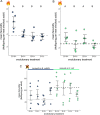Association with a novel protective microbe facilitates host adaptation to a stressful environment
- PMID: 33868708
- PMCID: PMC8045907
- DOI: 10.1002/evl3.223
Association with a novel protective microbe facilitates host adaptation to a stressful environment
Abstract
Protective symbionts can allow hosts to occupy otherwise uninhabitable niches. Despite the importance of symbionts in host evolution, we know little about how these associations arise. Encountering a microbe that can improve host fitness in a stressful environment may favor persistent interactions with that microbe, potentially facilitating a long-term association. The bacterium Bacillus subtilis protects Caenorhabditis elegans nematodes from heat shock by increasing host fecundity compared to the nonprotective Escherichia coli. In this study, we ask how the protection provided by the bacterium affects the host's evolutionary trajectory. Because of the stark fitness contrast between hosts heat shocked on B. subtilis versus E. coli, we tested whether the protection conferred by the bacteria could increase the rate of host adaptation to a stressful environment. We passaged nematodes on B. subtilis or E. coli, under heat stress or standard conditions for 20 host generations of selection. When assayed under heat stress, we found that hosts exhibited the greatest fitness increase when evolved with B. subtilis under stress compared to when evolved with E. coli or under standard (nonstressful) conditions. Furthermore, despite not directly selecting for increased B. subtilis fitness, we found that hosts evolved to harbor more B. subtilis as they adapted to heat stress. Our findings demonstrate that the context under which hosts evolve is important for the evolution of beneficial associations and that protective microbes can facilitate host adaptation to stress. In turn, such host adaptation can benefit the microbe.
Keywords: Experimental evolution; host adaptation; protective microbes.
© 2021 The Authors. Evolution Letters published by Wiley Periodicals LLC on behalf of Society for the Study of Evolution (SSE) and European Society for Evolutionary Biology (ESEB).
Conflict of interest statement
The authors declare no conflict of interest.
Figures




Similar articles
-
Coevolution's conflicting role in the establishment of beneficial associations.Evolution. 2022 May;76(5):1073-1081. doi: 10.1111/evo.14472. Epub 2022 Mar 31. Evolution. 2022. PMID: 35304743 Free PMC article.
-
The effects of Bacillus subtilis on Caenorhabditis elegans fitness after heat stress.Ecol Evol. 2019 Feb 18;9(6):3491-3499. doi: 10.1002/ece3.4983. eCollection 2019 Mar. Ecol Evol. 2019. PMID: 30962907 Free PMC article.
-
Impact of heat stress on the fitness outcomes of symbiotic infection in aphids: a meta-analysis.Proc Biol Sci. 2022 Mar 30;289(1971):20212660. doi: 10.1098/rspb.2021.2660. Epub 2022 Mar 30. Proc Biol Sci. 2022. PMID: 35350854 Free PMC article.
-
Experimental Evolution as an Underutilized Tool for Studying Beneficial Animal-Microbe Interactions.Front Microbiol. 2016 Sep 13;7:1444. doi: 10.3389/fmicb.2016.01444. eCollection 2016. Front Microbiol. 2016. PMID: 27679620 Free PMC article. Review.
-
The role of defensive symbionts in host-parasite coevolution.Biol Rev Camb Philos Soc. 2018 Nov;93(4):1747-1764. doi: 10.1111/brv.12417. Epub 2018 Apr 16. Biol Rev Camb Philos Soc. 2018. PMID: 29663622 Review.
Cited by
-
Still standing: The heat protection delivered by a facultative symbiont to its aphid host is resilient to repeated thermal stress.Curr Res Insect Sci. 2023 May 30;3:100061. doi: 10.1016/j.cris.2023.100061. eCollection 2023. Curr Res Insect Sci. 2023. PMID: 37304568 Free PMC article.
-
Cyclic-di-GMP promotes bacteria-host association.Nat Microbiol. 2023 Oct;8(10):1758-1759. doi: 10.1038/s41564-023-01479-8. Nat Microbiol. 2023. PMID: 37679598 No abstract available.
-
Microbial protection favors parasite tolerance and alters host-parasite coevolutionary dynamics.Curr Biol. 2022 Apr 11;32(7):1593-1598.e3. doi: 10.1016/j.cub.2022.01.063. Epub 2022 Feb 10. Curr Biol. 2022. PMID: 35148861 Free PMC article.
-
Microbes are potential key players in the evolution of life histories and aging in Caenorhabditis elegans.Ecol Evol. 2023 Sep 25;13(9):e10537. doi: 10.1002/ece3.10537. eCollection 2023 Sep. Ecol Evol. 2023. PMID: 37753311 Free PMC article.
-
Coevolution's conflicting role in the establishment of beneficial associations.Evolution. 2022 May;76(5):1073-1081. doi: 10.1111/evo.14472. Epub 2022 Mar 31. Evolution. 2022. PMID: 35304743 Free PMC article.
References
Grants and funding
LinkOut - more resources
Full Text Sources
Other Literature Sources

